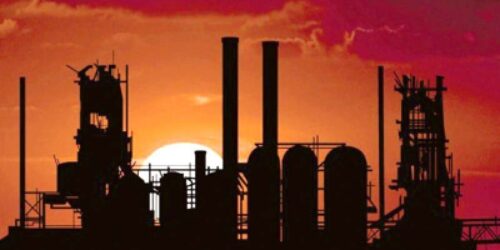In contrast to government hopes for a strong start to the new fiscal year, the large-scale manufacturing (LSM) sector contracted 4.9% in July 2021 over the preceding month.
Three reporting sources – the Oil Companies Advisory Committee (OCAC), the federal Ministry of Industries and the Provincial Bureaus of Statistics – reported an overall negative growth in the production by industries that they monitored in July over June this year, according to a report published by the Pakistan Bureau of Statistics (PBS) on Wednesday.
The OCAC reported a contraction of 0.3%, the Ministry of Industries put the negative growth at 3.9% and the provincial bureaus showed a negative growth of 0.7% in July over June this year, according to the national data collecting agency.
As a result, the LSM sector recorded a negative growth of 4.9% in July – the first month of current fiscal year 2021-22.
The LSM index dropped to 138, which was the lowest point in the past 10 months, according to the PBS data.
On a year-on-year basis, there was a growth of 2.3% in July over the same month of previous fiscal year, according to the PBS. The year-on-year growth was, however, not in line with the annual LSM growth target of 6% for the current fiscal year.
Last month, the Ministry of Finance had voiced hope that the country would see a strong LSM growth year-on-year in July but the results appeared to be contrary to the expectation.
“In July 2021, the MEI (Monthly Economic Indicator) is showing continued strong growth, thus, a strong year-on-year growth of LSM is expected in July on the basis of continued cyclical uptrend of CLI (composite leading indicator) in the main trading partners and domestic growth momentum,” said the Ministry of Finance’s monthly outlook report.
LSM had posted a growth of 14.9% in the last fiscal year, which the finance ministry attributed to the “resumption of economic activities, subsidised energy tariffs, construction package, relaxation in tariff rates for export-oriented industries and low borrowing costs by SBP”.
Year-on-year growth
On a year-on-year basis, out of 15 major industries, 11 saw a surge in production. However, out of these, the growth rate in 10 types of industries was less than 1% and in four cases it was nearly flat.
This suggests that the economic recovery is not deep-rooted, according to independent analysts.
The output of four industries showed a contraction in the first month of FY22 compared to the same period of previous fiscal year, according to the PBS.
The industrial sector has a major contribution in tax collection and the sector’s share in revenue is almost triple than its contribution to the overall economic output.
For the current fiscal year, the federal government has set the economic growth target at 5% and Finance Minister Shaukat Tarin said on Tuesday that there were signs that the government would surpass the growth target.
Tarin stated that he had asked the PBS to calculate quarterly GDP growth figures and he would share the news about July-September GDP growth in October with the media.
Prime Minister Imran Khan won the July 2018 elections on the promise of creating 10 million jobs and constructing five million homes at affordable costs but the promises have remain unfulfilled so far.
During its first three years in power, the government has not been able to achieve a growth rate where the economy could absorb all the new entrants into the market.
Data collected by the OCAC showed that 11 types of industries contracted a cumulative 0.2% in the first month of current fiscal year over a year ago.
The Ministry of Industries, which monitors 15 industries, reported a marginal 0.9% growth in the LSM output in July. Provincial bureaus reported a cumulative growth of 1.6% in 11 industries.
Sectors that posted growth included textile that grew a mere 0.4%, fertiliser rising 0.2% whereas the food, beverages and tobacco group recorded 0.09% growth.
The manufacturing output of chemical products increased 0.4% whereas the pharmaceutical sector registered a growth of 0.9%.
The automobile sector grew 2.1%, which was also the highest growth rate by any sector in the first month of FY22.
Iron and steel products’ output rose a mere 0.4%, electronics 0.05%, leather products 0.1% and engineering products 0.01%. Wood products showed a flat growth.
Industries that registered a dip in manufacturing included coke and petroleum products with 0.2% contraction, non-metallic mineral products that showed a negative 1.5% growth, paper and board with 0.3% contraction and rubber products with a decline of 0.1%.





